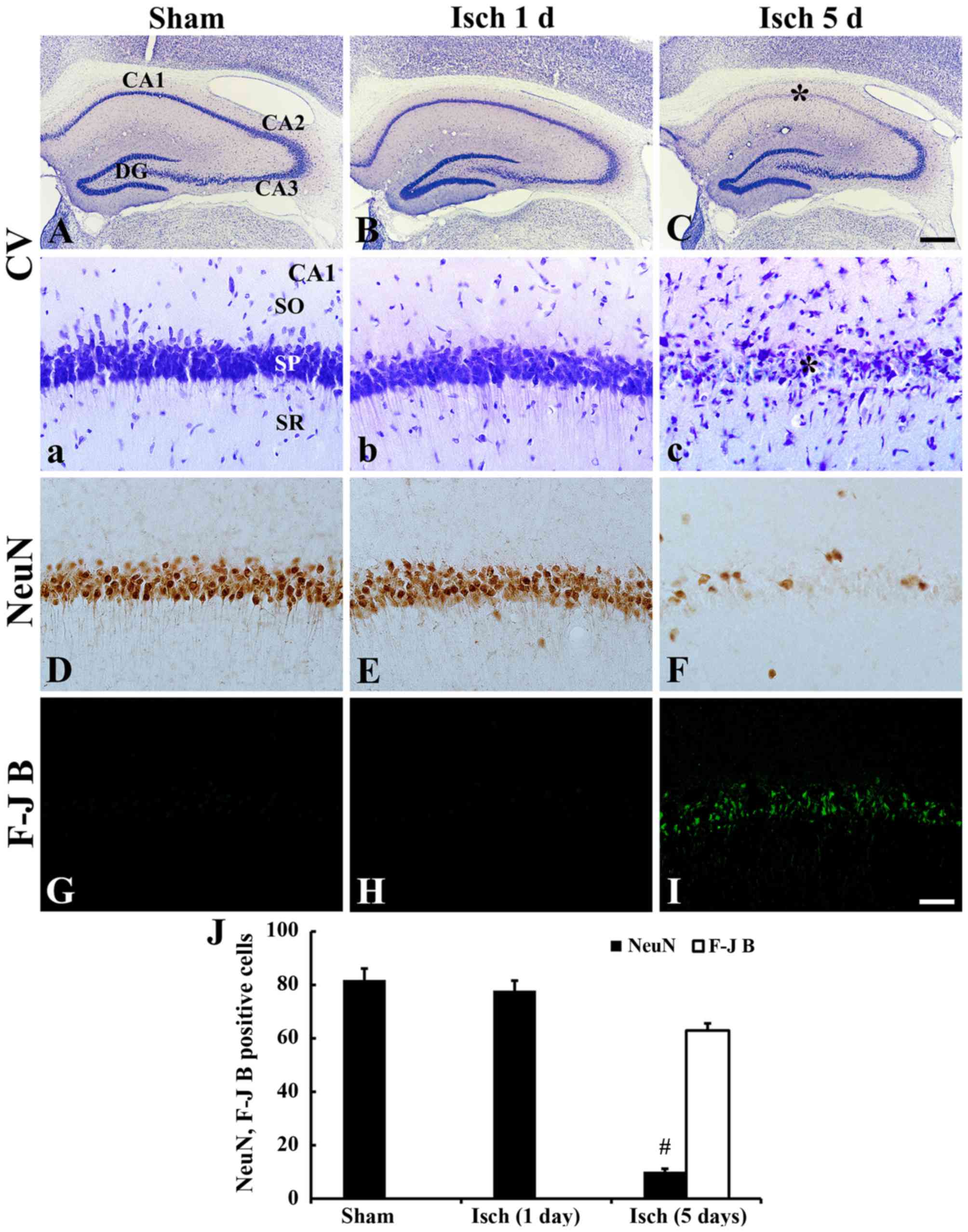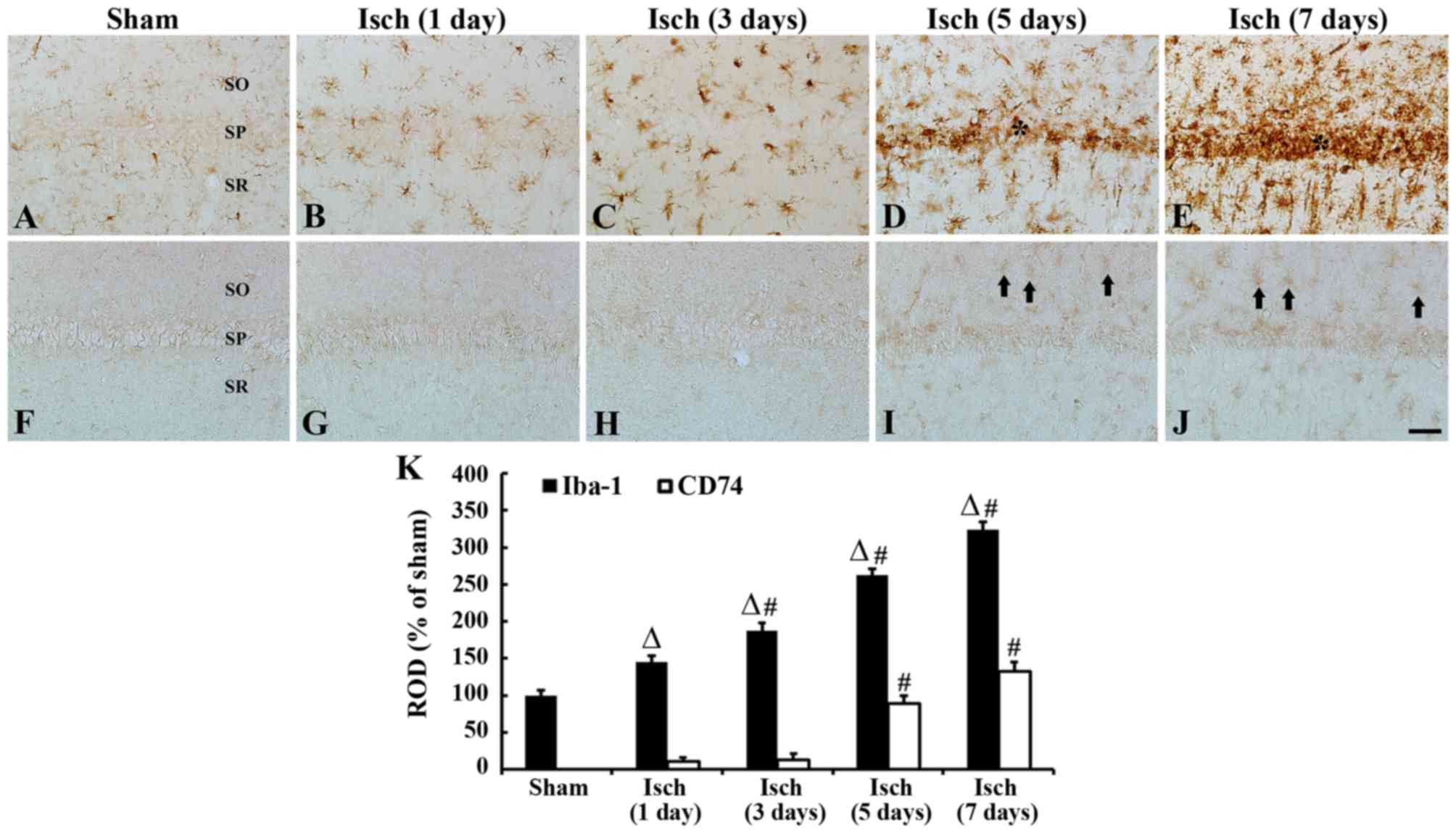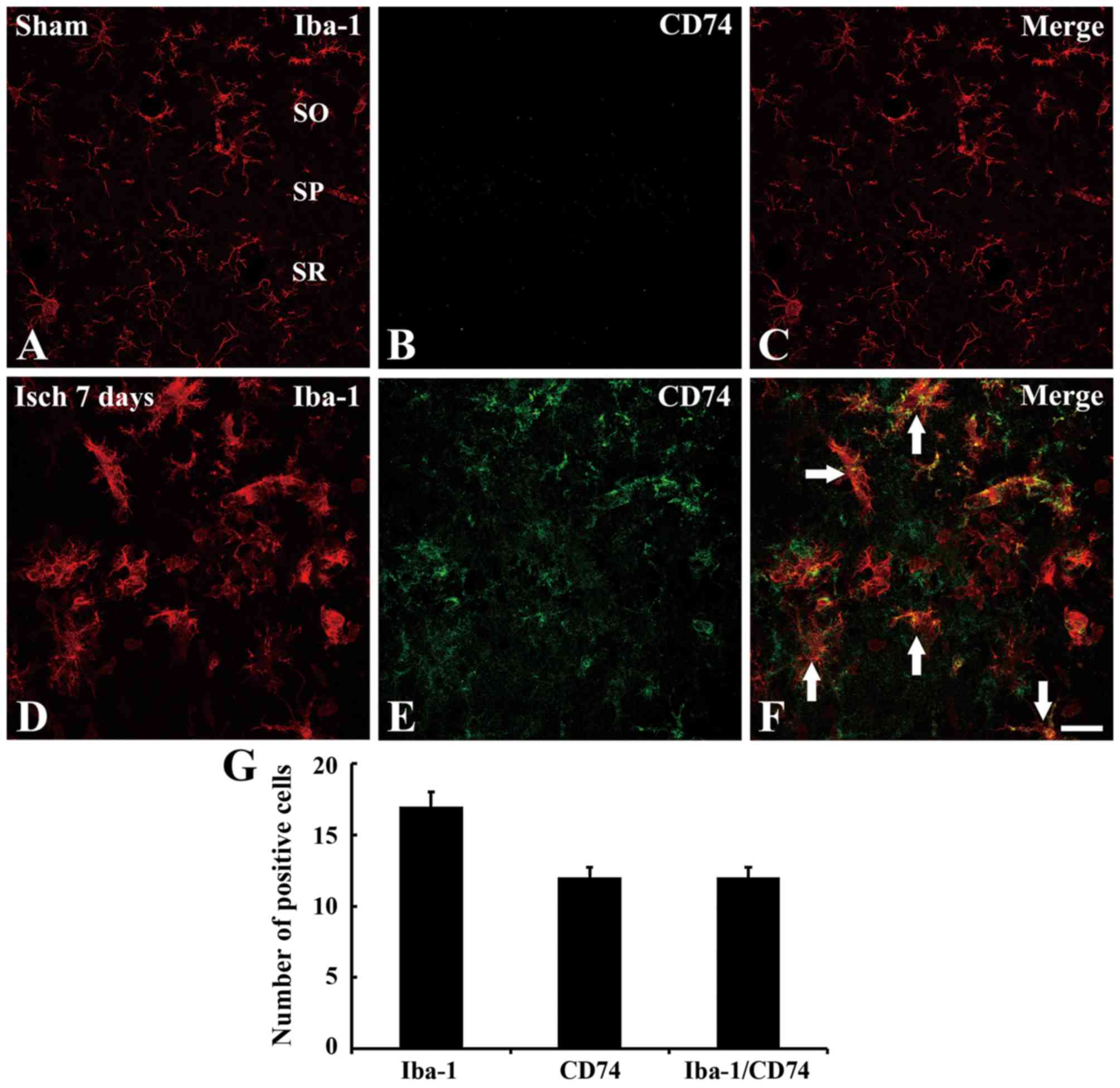|
1
|
Danton GH and Dietrich WD: Inflammatory
mechanisms after ischemia and stroke. J Neuropathol Exp Neurol.
62:127–136. 2003. View Article : Google Scholar
|
|
2
|
Stoll G and Jander S: The role of
microglia and macrophages in the pathophysiology of the CNS. Prog
Neurobiol. 58:233–247. 1999. View Article : Google Scholar
|
|
3
|
Kreutzberg GW: Microglia: A sensor for
pathological events in the CNS. Trends Neurosci. 19:312–318. 1996.
View Article : Google Scholar
|
|
4
|
Lees GJ: The possible contribution of
microglia and macrophages to delayed neuronal death after ischemia.
J Neurol Sci. 114:119–122. 1993. View Article : Google Scholar
|
|
5
|
Stoll G, Jander S and Schroeter M:
Inflammation and glial responses in ischemic brain lesions. Prog
Neurobiol. 56:149–171. 1998. View Article : Google Scholar
|
|
6
|
Kato H: The role of microglia in ischemic
brain injuryInflammation and Stroke. Springer; pp. 89–99. 2001,
View Article : Google Scholar
|
|
7
|
Nakajima K, Tsuzaki N, Shimojo M, Hamanoue
M and Kohsaka S: Microglia isolated from rat brain secrete a
urokinase-type plasminogen activator. Brain Res. 577:285–292. 1992.
View Article : Google Scholar
|
|
8
|
Vaca K and Wendt E: Divergent effects of
astroglial and microglial secretions on neuron growth and survival.
Exp Neurol. 118:62–72. 1992. View Article : Google Scholar
|
|
9
|
Colton CA and Gilbert DL: Production of
superoxide anions by a CNS macrophage, the microglia. FEBS Lett.
223:284–288. 1987. View Article : Google Scholar
|
|
10
|
Han HS, Qiao Y, Karabiyikoglu M, Giffard
RG and Yenari MA: Influence of mild hypothermia on inducible nitric
oxide synthase expression and reactive nitrogen production in
experimental stroke and inflammation. J Neurosci. 22:3921–3928.
2002.
|
|
11
|
Stumm R, Culmsee C, Schafer MK,
Krieglstein J and Weihe E: Adaptive plasticity in tachykinin and
tachykinin receptor expression after focal cerebral ischemia is
differentially linked to gabaergic and glutamatergic
cerebrocortical circuits and cerebrovenular endothelium. J
Neurosci. 21:798–811. 2001.
|
|
12
|
Maeda Y, Matsumoto M, Hori O, Kuwabara K,
Ogawa S, Yan SD, Ohtsuki T, Kinoshita T, Kamada T and Stern DM:
Hypoxia/reoxygenation-mediated induction of astrocyte interleukin
6: A paracrine mechanism potentially enhancing neuron survival. J
Exp Med. 180:2297–2308. 1994. View Article : Google Scholar :
|
|
13
|
Suzuki S, Tanaka K, Nogawa S, Nagata E,
Ito D, Dembo T and Fukuuchi Y: Temporal profile and cellular
localization of interleukin-6 protein after focal cerebral ischemia
in rats. J Cereb Blood Flow Metab. 19:1256–1262. 1999. View Article : Google Scholar
|
|
14
|
Hwang IK, Yoo KY, Kim DW, Choi SY, Kang
TC, Kim YS and Won MH: Ionized calcium-binding adapter molecule 1
immunoreactive cells change in the gerbil hippocampal CA1 region
after ischemia/reperfusion. Neurochem Res. 31:957–965. 2006.
View Article : Google Scholar
|
|
15
|
Kigerl KA, Gensel JC, Ankeny DP, Alexander
JK, Donnelly DJ and Popovich PG: Identification of two distinct
macrophage subsets with divergent effects causing either
neurotoxicity or regeneration in the injured mouse spinal cord. J
Neurosci. 29:13435–13444. 2009. View Article : Google Scholar :
|
|
16
|
Hu X, Li P, Guo Y, Wang H, Leak RK, Chen
S, Gao Y and Chen J: Microglia/macrophage polarization dynamics
reveal novel mechanism of injury expansion after focal cerebral
ischemia. Stroke. 43:3063–3070. 2012. View Article : Google Scholar
|
|
17
|
Perego C, Fumagalli S and De Simoni MG:
Temporal pattern of expression and colocalization of
microglia/macrophage phenotype markers following brain ischemic
injury in mice. J Neuroinflammation. 8:1742011. View Article : Google Scholar :
|
|
18
|
Sudduth TL, Schmitt FA, Nelson PT and
Wilcock DM: Neuroinflammatory phenotype in early Alzheimer's
disease. Neurobiol Aging. 34:1051–1059. 2013. View Article : Google Scholar
|
|
19
|
Frieler RA, Meng H, Duan SZ, Berger S,
Schütz G, He Y, Xi G, Wang MM and Mortensen RM: Myeloid-specific
deletion of the mineralocorticoid receptor reduces infarct volume
and alters inflammation during cerebral ischemia. Stroke.
42:179–185. 2011. View Article : Google Scholar
|
|
20
|
Liu YR, Lei RY, Wang CE, Zhang BA, Lu H,
Zhu HC and Zhang GB: Effects of catalpol on ATPase and amino acids
in gerbils with cerebral ischemia/reperfusion injury. Neurol Sci.
35:1229–1233. 2014. View Article : Google Scholar
|
|
21
|
Min D, Mao X, Wu K, Cao Y, Guo F, Zhu S,
Xie N, Wang L, Chen T, Shaw C and Cai J: Donepezil attenuates
hippocampal neuronal damage and cognitive deficits after global
cerebral ischemia in gerbils. Neurosci Lett. 510:29–33. 2012.
View Article : Google Scholar
|
|
22
|
Qi J, Li Y, Zhang H, Cheng Y, Sung Y, Cao
J, Zhao Y and Wang F: A novel conjugate of low-molecular-weight
heparin and Cu, Zn-superoxide dismutase: Study on its mechanism in
preventing brain reperfusion injury after ischemia in gerbils.
Brain Res. 1260:76–83. 2009. View Article : Google Scholar
|
|
23
|
Zhang YB, Kan MY, Yang ZH, Ding WL, Yi J,
Chen HZ and Lu Y: Neuroprotective effects of N-stearoyltyrosine on
transient global cerebral ischemia in gerbils. Brain Res.
1287:146–156. 2009. View Article : Google Scholar
|
|
24
|
Institute of Laboratory Animal Research,
Committee for the Update of the Guide for the Care and Use of
Laboratory Animals, National Research Council, . Guide for the care
and use of laboratory animals. 8th. National Academies Press;
Washington, DC: pp. 2202011
|
|
25
|
Lee CH, Park JH, Yoo KY, Choi JH, Hwang
IK, Ryu PD, Kim DH, Kwon YG, Kim YM and Won MH: Pre- and
post-treatments with escitalopram protect against experimental
ischemic neuronal damage via regulation of BDNF expression and
oxidative stress. Exp Neurol. 229:450–459. 2011. View Article : Google Scholar
|
|
26
|
Park JH, Shin BN, Chen BH, Kim IH, Ahn JH,
Cho JH, Tae HJ, Lee JC, Lee CH, Kim YM, et al: Neuroprotection and
reduced gliosis by atomoxetine pretreatment in a gerbil model of
transient cerebral ischemia. J Neurol Sci. 359:373–380. 2015.
View Article : Google Scholar
|
|
27
|
Schmued LC and Hopkins KJ: Fluoro-Jade B:
A high affinity fluorescent marker for the localization of neuronal
degeneration. Brain Res. 874:123–130. 2000. View Article : Google Scholar
|
|
28
|
Lee CH, Park JH, Cho JH, Ahn JH, Yan BC,
Lee JC, Shin MC, Cheon SH, Cho YS, Cho JH, et al: Changes and
expressions of Redd1 in neurons and glial cells in the gerbil
hippocampus proper following transient global cerebral ischemia. J
Neurol Sci. 344:43–50. 2014. View Article : Google Scholar
|
|
29
|
Loskota WJ, Lomax P and Verity MA: A
stereotaxic atlas of the mongolian gerbil brain (Meriones
unguiculatus). Mich Ann Arbor Science. 1974.
|
|
30
|
Yan BC, Park JH, Ahn JH, Choi JH, Yoo KY,
Lee CH, Cho JH, Kim SK, Lee YL, Shin HC and Won MH: Comparison of
glial activation in the hippocampal CA1 region between the young
and adult gerbils after transient cerebral ischemia. Cell Mol
Neurobiol. 32:1127–1138. 2012. View Article : Google Scholar
|
|
31
|
Finsen BR, Jørgensen MB, Diemer NH and
Zimmer J: Microglial MHC antigen expression after ischemic and
kainic acid lesions of the adult rat hippocampus. Glia. 7:41–49.
1993. View Article : Google Scholar
|
|
32
|
Imai Y, Ibata I, Ito D, Ohsawa K and
Kohsaka S: A novel gene iba1 in the major histocompatibility
complex class III region encoding an EF hand protein expressed in a
monocytic lineage. Biochem Biophys Res Commun. 224:855–862. 1996.
View Article : Google Scholar
|
|
33
|
Ito D, Imai Y, Ohsawa K, Nakajima K,
Fukuuchi Y and Kohsaka S: Microglia-specific localisation of a
novel calcium binding protein, Iba1. Brain Res Mol Brain Res.
57:1–9. 1998. View Article : Google Scholar
|
|
34
|
Gehrmann J, Bonnekoh P, Miyazawa T,
Hossmann KA and Kreutzberg GW: Immunocytochemical study of an early
microglial activation in ischemia. J Cereb Blood Flow Metab.
12:257–269. 1992. View Article : Google Scholar
|
|
35
|
Gehrmann J, Bonnekoh P, Miyazawa T,
Oschlies U, Dux E, Hossmann KA and Kreutzberg GW: The microglial
reaction in the rat hippocampus following global ischemia:
Immuno-electron microscopy. Acta Neuropathol. 84:588–595. 1992.
View Article : Google Scholar
|
|
36
|
Kirino T: Delayed neuronal death in the
gerbil hippocampus following ischemia. Brain Res. 239:57–69. 1982.
View Article : Google Scholar
|
|
37
|
Miyawaki S, Imai H, Hayasaka T, Masaki N,
Ono H, Ochi T, Ito A, Nakatomi H, Setou M and Saito N: Imaging mass
spectrometry detects dynamic changes of phosphatidylcholine in rat
hippocampal CA1 after transient global ischemia. Neuroscience.
322:66–77. 2016. View Article : Google Scholar
|
|
38
|
Pulsinelli WA, Brierley JB and Plum F:
Temporal profile of neuronal damage in a model of transient
forebrain ischemia. Ann Neurol. 11:491–498. 1982. View Article : Google Scholar
|
|
39
|
Leng L, Metz CN, Fang Y, Xu J, Donnelly S,
Baugh J, Delohery T, Chen Y, Mitchell RA and Bucala R: MIF signal
transduction initiated by binding to CD74. J Exp Med.
197:1467–1476. 2003. View Article : Google Scholar :
|

















